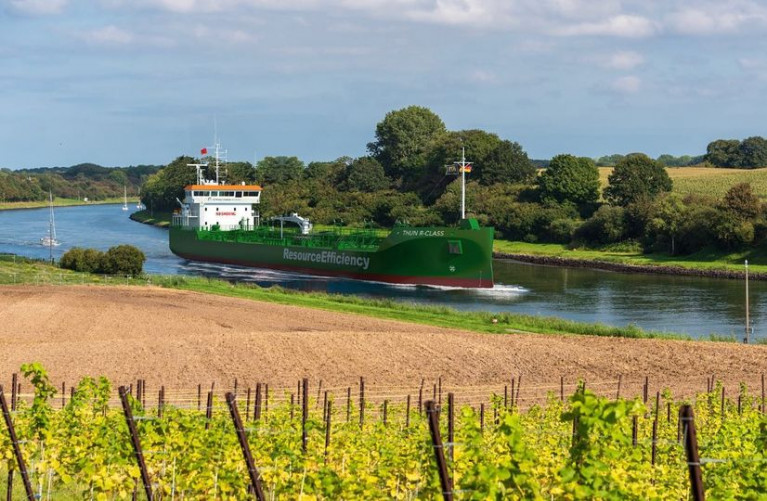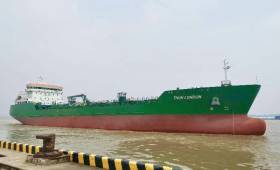Displaying items by tag: Thun Tankers
Frequent Irish ports caller, Thun Tankers whose fleet continues to expand as the Scandinavian shipping company haved place an order for a pair of 7,999 mts dwt tankers.
Thun Tankers is part of the Erik Thun Group, a company owned by the Källsson family since 1938, with the Swedish lake-based group engaged in operations among them between Milford Haven,Wales to Irish Ports.
As for the two ordered R-Class vessels, they are a further development of Thuns’ existing vessels among them the E-class as Afloat previously reported. Focus on resource efficiency, environmental responsibility and logistical reliability has been key in the design process of the R class.
"The scope for the “R-Class” series have been to build the most resource efficient vessels available for the trade, with minimal environmental impact. Thun’s long experience of building high performing quality vessels has been used in the design process. We have been combining this with a number of new features to further improve performance while reducing our climate footprint" said Joakim Lund, CCO at Thun Tankers BV.
The ships, that will be built by Scheepswerf Ferus Smit BV in the Netherlands, will be delivered during first half 2024. Ferus Smit BV has previously built forty ships for Erik Thun.
The main characteristics for the R class vessels are:
• Length overall about 114.95 m
• Breath moulded about 15.87 m
• Max dwt draft 6.9 m
• Deadweight about 7999 ton
• Cargo tank capacity about 9540 m3
• Ice Class 1A (Finnish Swedish)
Upon delivery they will enter into the Gothia Tanker Alliance network and be technically managed by MF Shipping Group.
Adaptive propulsion to minimize energy usage, UPS battery pack, the latest hull design and the newest and most resource efficient machinery are some examples of the vessels new features.
As part of the inaugural Irish Port Safety Week, among the ports participating was Shannon Foynes Port Company and which involved the call of a short-sea petroleum products tanker, writes Jehan Ashmore.
The Thun Gemini arrived to the Shannon Estuary port of Foynes to discharge a cargo of petroleum. Such berthing requires preparedness and which is key to ensure safe and effective mooring operations are adhered to.
Berthing of the 4,100dwt Thun Gemini involved planning and appropriate procedures are followed as safe mooring must withstand the combined potential natural forces, such as wind, current and tide.
Thun Gemini is no stranger to Irish Ports including the east coast with fleetmates of the Thun Tankers operated vessel frequently plying in the Irish Sea having made passage through the Celtic Sea laden with cargoes loaded at the Pembrokeshire estuary of Milford Haven in south Wales. This is the UK's largest energy port that handles over 30 million tonnes of cargo annually.
Since last week's exercise took place at Foynes, Afloat tracked the Thun Gemini, having departed and rounded the south-west coast before heading off the entrance of Cork Harbour where the vessel currently remains at anchorage.
The 2003 built G-class vessel is operated by a Swedish lake-based shipowner, Thun Tankers (Erik Thun Group) whose homeport of Lidköping is located on Lake Vänern. This is the third largest lake in Europe which is connected by a sea canal to the west coast of the Scandinvian nation.
In recent years the 114m Dutch flagged tanker made an unusual call to Dun Laoghaire Harbour, this was to facilitate maintenance work which took place alongside the Carlisle Pier.
Brand New Chinese Built Tanker for Swedish Lake Based Shipping Group Arrives in Dublin Port
A brand new Chinese built Dutch flagged tanker ordered by a Swedish lake based shipping group arrived into Dublin Port from Wales this morning, writes Jehan Ashmore.
The L-class leadship Thun Lidkoping is the first of five 18,650 deadweight chemical product tankers which was completed by Avic Dingheng Shipbuilding Ltd in China.
The name chosen for the leadship operated by Thun Tankers (Erik Thun Group), derived from the shipowner group's inland homeport of Lidköping located on the southern shores of Lake Vänern. This is the third largest lake in Europe which is connected to the sea by shipping canals.
The L-class each with a cubic capacity of (98%) 20,665 m3, have a design developed in-house using Erik Thun AB's long experience of building sustainable, high quality vessels that operate as a major player in northern Europe.
In terms of environmental care, a concerted focus has been made with new regulations and customers’ needs taken into the key design and building process of this new class type.
The 148m tanker along with second sister, Thun London which too was delivered recently, operate in the Gothia Tanker Alliance network while crewing and technical management is conducted through MF Shipping Group.
This morning's arrival in Dublin Bay of Thun Lidkoping from Milford Haven, Wales, also involved Afloat to track a passing fleetmate, Thun Gemini which had departed Dublin Port having docked at Oil Berth No.1. It was at the adjacent berth that Thun Lidkoping berthed, though the maiden call of the newbuild tanker took place at the Irish port only last month.
As for Thun Gemini, the smaller G -Class tanker is returning to the same south Wales port which saw a passage offshore of Dun Laoghaire Harbour where Afloat reported of the tanker's once-off call to enable maintenance carried out at the south Dublin Bay port.
Such a call by the 2003 built 4,100dwt tanker was notably a rare occurance for such a vessel type which as previously reported took place three decades ago.































































